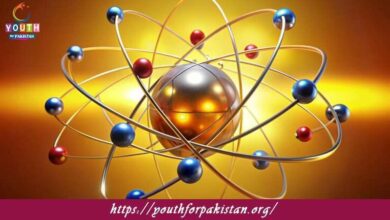12th Class Physics Chapter 20 Quiz with Answers

“12th Class Physics Chapter 20 Quiz: Atomic Spectra” throws light on the interesting behavior of atoms when they are treated with different energies, and the phenomena of emission and absorption spectra are discussed. For MDCAT students, the concept of atomic spectra is very important in understanding the quantization of energy levels within the atoms and how atoms emit or absorb light. This chapter contains all concepts related to the interaction between light and matter. Our MDCAT Quiz for this chapter will help you test your knowledge and prepare for relevant questions in the MDCAT exam.
Introduction to Atomic Spectra
The chapter starts with the introduction of atomic spectra, which are created when atoms release or absorb light. The electrons in an atom are found in specific energy levels, and when an electron moves from one such level to another, it absorbs or emits energy in the form of light. Since this is associated with particular wavelengths of light, it leads to an atomic spectrum. Students will find out that atomic spectra are characteristic for each element and can therefore be regarded as the fingerprint of the atom. Also, this part will mention the significance of spectroscopy for research and its role in such fields as astronomy and chemistry.
Kinds of Atomic Spectra
This chapter comprises details on two kinds of atomic spectra: emission spectra and absorption spectra.
Emission Spectra: The electron in an atom absorbs energy and jumps to a higher energy level. After some time, it falls back to its original level and the energy is emitted as light. The emitted light is not a continuum, but a discreet set of lines known as the emission spectrum. The spectrum contains characteristic wavelengths which can be identified as specific colors of light. Students will see how the Balmer series, Lyman series, and Paschen series result from different transitions of electrons in hydrogen atoms, giving rise to different emission lines.
Absorption Spectra: When white light passes through an atom or a gas, certain wavelengths of light are absorbed, and an atom or gas appears as dark lines in the spectrum. The lines represent energy gaps between allowed energy levels of the electron. The absorption spectrum is just the reverse of an emission spectrum, representing the wavelengths of light that an atom absorbs rather than emits.
Bohr’s Model and Atomic Spectra
Another important focus of this chapter is the Bohr model of the atom, which explains atomic spectra based on quantum theory. Bohr put forth the postulate that electrons orbit the nucleus in discrete energy levels and that energy is emitted or absorbed only when an electron makes a transition between these energy levels. The energy of the photon absorbed or emitted during such transitions is equal to the difference in energies corresponding to the two energy levels involved. The students would learn how this model by Bohr satisfactorily explained the spectral lines of the hydrogen atom, as observed in the Balmer series and the Lyman series.
Quantum Mechanical Explanation of Atomic Spectra
The quantum mechanical explanation of atomic spectra, which is an extension of the principles of wave-particle duality and Heisenberg’s uncertainty principle, will be studied by students following Bohr’s model. The Schrödinger equation and the associated concept of wavefunctions provide a much more appropriate model for the behavior of electrons in atoms. This means that electrons do not follow definite orbits as suggested by Bohr but are found in regions of space called orbitals. Each orbital corresponds with a specific energy level, and the jumping of electrons from one orbital to another corresponds to the absorption or emission of specific wavelengths of light.
MDCAT Quiz: Test Your Knowledge of Atomic Spectra
Our MDCAT Quiz for Chapter 20 will help you determine how well you have understood significant concepts such as Bohr’s model, quantum theory, emission spectra, absorption spectra, and hydrogen spectral series. The quiz has been designed to see how well you have understood the important topics discussed in this chapter, preparing you for questions regarding the MDCAT.
- Test Name: 12th Class Physics Chapter 20 Quiz
- Type: Quiz Test
- Total Questions: 30
- Total Marks: 30
- Time: 30 minutes
Note: Answer of the questions will change randomly each time you start the test, once you are finished, click the View Results button.
Free Flashcards for Atomic Spectra
To further solidify your learning, use free flashcards for Chapter 20. These flashcards cover key topics such as Bohr’s model, the Rydberg formula, the Lyman series, Balmer series, quantum mechanics, etc. Flashcards are an effective tool for revising key ideas and improving memory retention while preparing for the MDCAT exam.

What is the term for the emission of light by atoms or molecules when excited by an external source?
Luminescence

What is the term for the process of measuring both the position and momentum of a particle simultaneously to a high degree of precision impossible?
Heisenberg uncertainty principle

What is the term for the study of atomic and molecular interactions with electromagnetic radiation?
Spectroscopy

What is the term for the process where the wavelength of X-rays changes when scattered by electrons?
Compton effect

What is the term for the phenomenon where a moving source of waves changes the observed frequency of the waves?
Doppler effect

What is the term for the emission of light by a substance after it has absorbed energy and re-emits it as visible light?
Luminescence

What is the term for the process where a substance absorbs electromagnetic radiation and re-emits it as visible light?
Fluorescence

What is the term for the emission of light by a substance after it has absorbed electromagnetic radiation?
Luminescence

What is the term for the emission of light by atoms or molecules when excited by an external source?
Luminescence

What is the term for the process of measuring both the position and momentum of a particle simultaneously to a high degree of precision impossible?
Heisenberg uncertainty principle

What is the term for the study of atomic and molecular interactions with electromagnetic radiation?
Spectroscopy

What is the term for the process where the wavelength of X-rays changes when scattered by electrons?
Compton effect

What is the term for the phenomenon where a moving source of waves changes the observed frequency of the waves?
Doppler effect

What is the term for the emission of light by a substance after it has absorbed energy and re-emits it as visible light?
Luminescence

What is the term for the process where a substance absorbs electromagnetic radiation and re-emits it as visible light?
Fluorescence

What is the term for the emission of light by a substance after it has absorbed electromagnetic radiation?
Luminescence

What is the term for the emission of light by atoms or molecules when excited by an external source?
Luminescence

What is the term for the process of measuring both the position and momentum of a particle simultaneously to a high degree of precision impossible?
Heisenberg uncertainty principle
Experience the real exam environment with our expertly designed collection of over 25,000 MCQs MDCAT Mock Tests.





